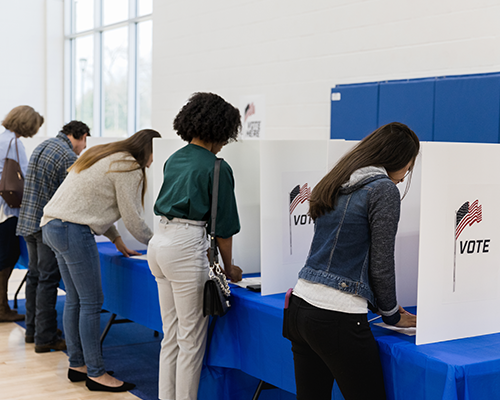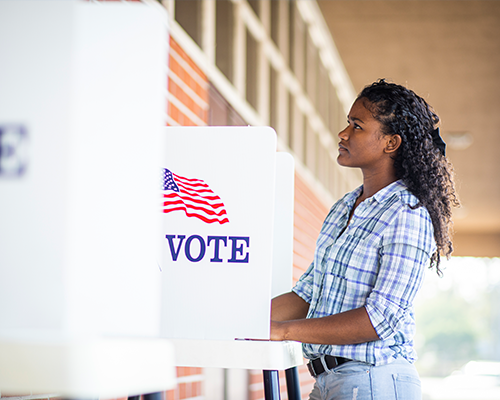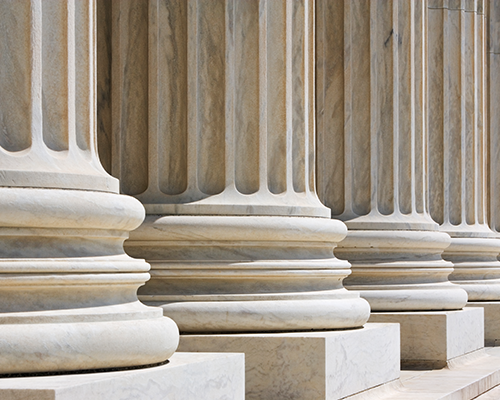
Who can vote by mail in
Pennsylvania?










All registered voters in
Pennsylvania may vote by mail.
Do You Have To Apply To Get A Mail-In or Absentee Ballot?
Yes. In order to vote by mail or absentee, you must request a ballot online or from your county election board in person.
For more information on the difference between mail-in and absentee voting, see HOW DO YOU GET & CAST A BALLOT?
Applications for absentee or mail-in ballots must be received by the county election board no later than 5 p.m. seven days before Election Day.
As a security measure, a voter’s application to vote by mail must include:
- their name as registered;
- the number of their PA driver’s license, PennDOT-issued photo ID, the last 4 digits of their Social Security number, or an alternative photo ID;
- their date of birth; and
- their mailing address.
When a voter applies to vote by mail, their eligibility to vote and personal information is verified. County election officials run all mail ballot applications through HAVA (Help America Vote Act) data verification to ensure every applicant’s identity is verified and their citizenship is checked. Anyone submitting a vote by mail application without proof of identification, such as a driver’s license number, will receive a notice requiring them to provide proof of ID with the completed absentee ballot or the ballot will not be counted.
The county election board must receive a voter’s application to vote by mail or as an absentee voter at least seven days before the election. Voters can apply online to vote by mail and are encouraged to apply as soon as possible. Voters can also apply in person at their county election board.
After a voter’s application has been processed and approved, their county election board mails them a trackable, secure mail ballot via the U.S. Postal Service.

What should I know about my mail-in ballot or absentee ballot?
The Pennsylvania Department of State recommends voters return mailed ballots as soon as possible. Absentee and mail-in ballots must be received by the county election board by 8 p.m. on Election Day. You can find your county election board’s address here.
A mail-in or absentee ballot contains (1) the ballot, (2) a secrecy envelope to keep your vote confidential, and (3) an outer return envelope, with printed instructions for and a Voter’s Declaration which must be filled out.
Mail-in ballots should be filled in with blue or black ink. Mail-in and absentee ballots will be rejected if voters forget to sign the declaration on the outer envelope, forget to date the declaration, or forget to include the secrecy envelope. The secrecy envelope is the inner envelope, labeled “Official Election Ballot.” Do not write on the secrecy envelope. Voters should make sure their ballot is filled in, placed inside the secrecy envelope, and then put in the outer return envelope which is properly filled out, signed and dated.
Voters can return their completed ballot:
- by mail,
- by depositing it in an authorized and secure ballot drop box (where available), or
- in person at their county election board or a location officially designated by their county election board.
Return the ballot yourself unless you have a disability that allows you to designate another person to return your ballot. Mail-in and absentee ballots can be tracked to determine their status.
Double-check your county election board’s website to see if your county requires paid postage, though this should be indicated on the return envelope.
Ballots must be received by the county election board before 8 p.m. on Election Day.
Mail ballots are secure because they are tracked through the collection and counting process. Mail ballot drop boxes are secure because they are locked and only accessible to authorized election officials.
Voting by mail has been used in Pennsylvania and the United States since the Civil War and has a long history of being safe and secure. In 2019, the Pennsylvania legislature passed Act 77, which gave all registered voters the right to cast their vote using a mail-in ballot.
It is a crime to cast a vote using someone else’s vote-by-mail ballot.
Returning an Absentee or Mail-in Ballot via Secure Drop box
Many, but not all counties maintain ballot drop boxes. Check with your local board of elections to find their locations and hours.
Ballot drop boxes are clearly labeled, securely locked, and in public, well-lit areas with good visibility. They are often monitored by staff, or by video.
Voters must insert their ballot into an official, marked drop box by 8 p.m. on Election Day (unless their county imposes an earlier deadline for their drop boxes) for it to be counted and should otherwise follow local rules. Local election officials and their staff regularly collect ballots from drop boxes and securely transfer them to the county election board office, ensuring chain-of-custody of the ballots is maintained.

Some counties in Pennsylvania have secure drop boxes for voters to deposit their completed mail-in or absentee ballots. Ballot drop boxes in Pennsylvania are clearly labeled, securely locked, and in public, well-lit areas with good visibility. Only county election staff are authorized to collect and securely transfer ballots from the drop box to the county election board.
Returning a Mail-In or Absentee Ballot in Person
Voters may deliver their mail-in or absentee ballots to in-person voting sites until 8 p.m. on Election Day in some counties and locations.
Can you vote in person if you requested a mail-in ballot?
Election officials keep a list of voters who applied for mail-in or absentee ballots. If a voter submits their ballot, and it is accepted and processed, that is also recorded. A voter who has already cast a mail-in or absentee ballot will be flagged if they come in to vote in person. It is illegal to vote twice, and the state has checks in place to ensure this does not happen.
If a voter requested a mail-in or absentee ballot and decides not to use it, they may vote in person instead:
- If they bring their mail-in or absentee ballot and the pre-addressed outer return envelope and void it, they can then cast an in-person ballot. Voiding the absentee or mail-in ballot requires the voter to surrender the ballot and envelope and sign a declaration of doing so. The voided ballot will not be counted.
- If they do not have their mail-in or absentee ballot, they may cast an in-person vote, but it will be what is known as a “provisional ballot.” That ballot will be set aside and only be counted once the county election board confirms that the voter did not cast their mail-in or absentee ballot.
If the person has received a notice that their already-cast absentee or mail-in ballot may not be counted—for example because the signature was missing from the declaration envelope—they will be given a “provisional ballot” to submit in-person. Provisional ballots are set aside, and the county election board later determines whether they are eligible to be counted.
Can voters ask a friend to return their mail-in ballot?
No, with a few exceptions. Only voters with disabilities or voters who are facing an emergency may designate someone, in writing, to deliver their ballot.
No. Some people have used the term “ballot harvesting” to suggest that people return large numbers of ballots for other people or for people who are dead or aren’t real. This is illegal and has not been a problem in Pennsylvania. There are numerous safeguards to ensure that only legitimate ballots cast by registered Pennsylvania voters are counted. For example, absentee and mail-in ballots are sent only to registered voters, and the list of registered voters is regularly updated to remove people who have moved away or died or are otherwise ineligible to vote.
Claims of ballot harvesting, like those in the movie 2,000 Mules, have consistently been disproven and disavowed.
Processing Mail-In Ballots
Each county has a system for verifying the legitimacy of every mail-in and absentee ballot they receive and that each voter only votes once. This is done while preserving the privacy of a voter’s vote choices made on the ballot.
Typically, first, an election worker scans the barcode on the outside of the return envelope. This barcode is unique to each voter and ballot and allows the county election board to quickly and accurately verify that they have received the ballot that was mailed to the voter. This also lets the election official confirm that the voter did not submit another ballot.
Next, the worker checks the return envelope to see if the voter declaration was properly filled out, including whether it was signed and dated. Some counties can check whether the voter has used the mandatory secrecy envelope at this stage too. Some ballot return envelopes have a small window that enables the worker to see if the secrecy envelope is present. Some counties weigh the ballot return packages and call tell that it is too light to have the secrecy envelope.
Once the election worker verifies that the ballot envelope was properly submitted, has arrived on time, and that the voter has not already voted, the voter record is marked to show the ballot has been received and checked in. Only after that are ballots separated from the return envelope, which has identifying information. The secrecy envelope protects the anonymity of the voter, so there is no way for election workers to know who voted for which candidates.
The ballot may be rejected if the declaration on the return envelope is not signed, is missing a date, or if the secrecy envelope is missing. If there is a problem, many counties will notify the voter and offer an option to fix the problem. However, some will not provide that option. Check with your local county election board to determine if they have a program to let you fix errors.
This entire process ensures that each voter only votes once.
Ballots will be rejected if they arrive after 8 p.m. on Election Day.


How does
in-person voting work in Pennsylvania?
Prior to Election Day
While Pennsylvania does not have statewide in-person early voting, most counties allow voters to submit a mail-in or absentee ballot in-person at designated locations. If a voter hasn’t requested a mail-in ballot, they can submit an application to their county election office or other designated location by 8 p.m. one week before Election Day. Once the application is verified and processed, the voter can pick up their mail-in or absentee ballot at the designated location, fill it out, and submit it there.
Election Day
In-person voters must vote at their assigned polling place in the city or town where they registered. Polling places on Election Day are open from 7 a.m. to 8 p.m. Mail-in and absentee voters may still return their ballots to their county board of elections other designated ballot drop-off location on Election Day, but counties can only process ballots that they receive before the polls close at 8 p.m.
Pennsylvania only uses approved, certified voting machines that are not connected to the internet. These machines are publicly tested and maintained routinely ahead of each election to ensure they will provide accurate results.

Voter Identification
If a voter is casting a ballot for the first time in an election district, they must show proof of identification. This identification can be photo or non-photo. Acceptable non-photo identification must have the voter’s name and address. Acceptable forms of photo ID include a Pennsylvania driver’s license or PennDOT ID card. Voters may also use an ID issued by any Commonwealth agency, the U.S. government, a U.S. passport, a U.S. Armed Forces ID or a student or employer ID card.
Returning voters do not need to show identification.

Who Can Observe Pennsylvania Elections?
To become a poll watcher in Pennsylvania, there are a few requirements. Poll watchers must:
- Be registered to vote in the county where they want to be a poll watcher;
- Be appointed by a candidate in that electoral district or by a political party or political organization with candidates on the ballot in that district;
- Obtain a certificate from the county election board before the election. This certificate will state the poll watcher’s name and the name of the candidate, party, or political entity the poll watcher represents; and
- When requested, present their certificate to the local board of elections.
A poll watcher is allowed to challenge a voter’s qualifications, but only if:
- The challenge is made on a good-faith basis; and
- The challenge is made directly to the Judge of Elections on-site.
A poll watcher is not permitted to interfere with voters or approach them in the polling place. Additionally, any challenges made by a poll watcher cannot be based on race, national origin, appearance, surname, language, religion or other characteristics not relevant to qualifications to vote.
Learn more on where, when, and how to vote in Pennsylvania elections here.

Does Pennsylvania provide ballots for
military & overseas voters?
There is a special type of ballot for eligible military service members and certain Pennsylvania voters who live overseas. Like all other Pennsylvania voters, to register to receive such a ballot, these individuals must apply and show they meet the relevant criteria. These procedures are in line with federal and state law.
There are different types of overseas voters, and the type of voter someone is affects which elections you can vote in. Voters in the armed services who are stationed overseas and people registered to vote in Pennsylvania but living abroad may vote in the Commonwealth and vote in every contest for their district if they plan to return to the state. A third type, “federal voters,” were originally registered to vote in Pennsylvania but now permanently reside overseas and are no longer entitled to be registered to vote in the Commonwealth. These voters may only cast ballots for federal races, like the presidency. Federal voters must return their ballot to their county election board by 8 p.m. on Election Day.
Eligible military service members and other registered and eligible Pennsylvania voters living abroad are able to vote by absentee ballot.
Overseas voters should apply for and return their ballot as early as possible.
Overseas voters have several options to request an absentee ballot, as long as the request arrives at the county election board before Election Day:
- They may use an official absentee ballot request form.
- They may email a request to stsvcuocavaabs@pa.gov.
- They may request a paper absentee ballot application by emailing ST-UOCAVAQues@pa.gov.
- Voters in the military may complete and send the Federal Post Card Application form or the Federal Write-In Absentee form. Both should be sent to their county election board.
When submitting a military or overseas civilian ballot, there are two requirements that must be met for their ballot to be counted:
- The voter must affirm they mailed their ballot no later than 11:59 p.m. the day before Election Day.
- The county election board must receive their ballot no later than 5 p.m. seven days after Election Day.
